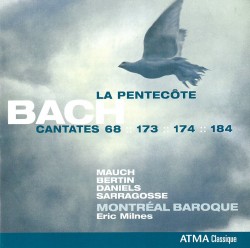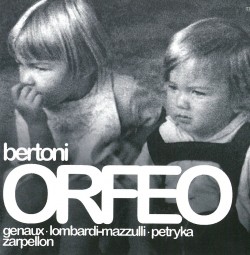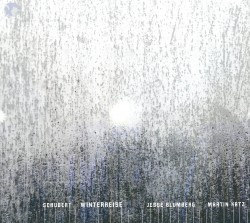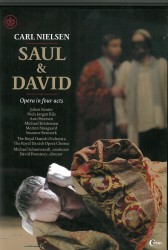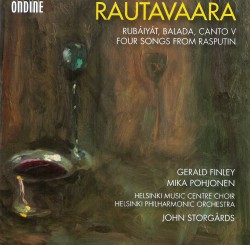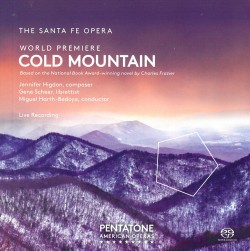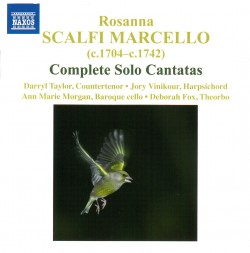Bizet – Carmen
Rice; Hymel; Argiris; Kovalevska; Royal Opera House; Constantinos Carydis
Opus Arte OA 1197 D
Bizet – Les Pêcheurs de perles
Ciofi; Korchak; Solari; Tagliavini; Orchestra e Coro del Teatro di San Carlo; Gabriele Ferro
Cmajor 719508
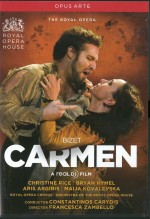 This release calls itself a film, but in reality it’s a DVD of Francesca Zambello’s 2006 staging that has seen better days like Jonas Kaufmann and Anna Caterina Antonacci, big name stars, but in another video. There were movies made of Carmen very successfully in the past with beautiful Seville as backdrop, real mountains, real bullfights, but this is nothing of the sort. It is shot in HD and even in 3D, obviously aimed at the mass market, because “Carmen sells” even for people who don’t know or care much about opera. The score is cut heavily by leaving out the “boring bits” like the intermezzos between acts, some of Bizet’s most beautiful music, making a rather short opera even shorter. The staging is traditional, expertly directed with unremarkable sets that leave lots of empty space for big crowds. There are all kinds of animals on stage, chickens, a donkey plus a beautiful black horse that carries in the torero Escamillo (Aris Argiris) who sings his big entry number on horseback. The production deserves praise for giving a chance to young singers who are attractive, enthusiastic, look the part, relaxed and athletic with fine, strong voices.
This release calls itself a film, but in reality it’s a DVD of Francesca Zambello’s 2006 staging that has seen better days like Jonas Kaufmann and Anna Caterina Antonacci, big name stars, but in another video. There were movies made of Carmen very successfully in the past with beautiful Seville as backdrop, real mountains, real bullfights, but this is nothing of the sort. It is shot in HD and even in 3D, obviously aimed at the mass market, because “Carmen sells” even for people who don’t know or care much about opera. The score is cut heavily by leaving out the “boring bits” like the intermezzos between acts, some of Bizet’s most beautiful music, making a rather short opera even shorter. The staging is traditional, expertly directed with unremarkable sets that leave lots of empty space for big crowds. There are all kinds of animals on stage, chickens, a donkey plus a beautiful black horse that carries in the torero Escamillo (Aris Argiris) who sings his big entry number on horseback. The production deserves praise for giving a chance to young singers who are attractive, enthusiastic, look the part, relaxed and athletic with fine, strong voices.
American tenor Bryan Hymel is no Alagna or Kaufmann, but has a strong, attractive voice and a certain vulnerability of character that makes him a believable Don José. His Flower Aria gets the biggest applause, deservedly. The role of Carmen is certainly what makes or breaks this opera and ROH chose mellifluous British mezzo Christine Rice who puts in an energetic and compelling performance and develops her character nicely from a seductress to tragic, defiant heroine, but the seconda donna, Maija Kovalevska (Micaela), an already highly accomplished Latvian soprano of wonderful stage presence, is a nice surprise and a joy to hear and behold.
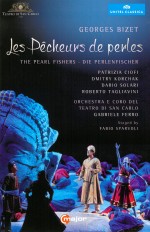 Most likely known by the famous duet Au fond du temple saint between the two male principals, Bizet’s second most famous opera has shared the fate of Carmen by being a disastrous failure on its premiere, so totally unappreciated by the French petit bourgeoisie that it pushed its genius composer into an early grave.
Most likely known by the famous duet Au fond du temple saint between the two male principals, Bizet’s second most famous opera has shared the fate of Carmen by being a disastrous failure on its premiere, so totally unappreciated by the French petit bourgeoisie that it pushed its genius composer into an early grave.
Nevertheless Les Pêcheurs de perles remains an exotic, atmospheric, gorgeously melodic score, coming to us from the resplendent 18th-century San Carlo opera house of Naples that has a 250-year tradition of singing excellence. Fabio Sparvoli’s visionary staging, all in shades of beautiful blues, evokes sultry Arabian Nights. There is an ever-present ballet of sinuous dancers representing the spirits of the sea, sometimes playful, sometimes menacing as in the third act when it all turns into bloodthirsty madness.
The heroine is a beautiful priestess enslaved by the Brahmins to keep her chastity on pain of death, but she defies her fate by falling in love, bringing on the wrath of Brahma, the creator god, and the morbidly superstitious mob of the pearl fisher community. Italian spinto soprano, Patrizia Ciofi, famous for her supple, light, wonderfully expressive voice, deserves the highest praise as the priestess Leila, a role ranging from religious chant to dreamy love song in the night, a love duet and later tempestuous rage fighting for the life of her beloved. The lover, Nadir, is Russian lyric tenor sensation, Dmitry Korchak, who delivers the romance Je crois entendre encore, one of the most beloved melodies ever written and even turned into a pop song. Uruguayan baritone Dario Solari is a powerful and noble Zurga who gives up the girl he loves and brings death on himself by letting the lovers escape. Conducted with great expertise by the 80-year-old master, Gabriele Ferro. Beautiful story, enchanting music, eye-popping scenery. A moving performance.
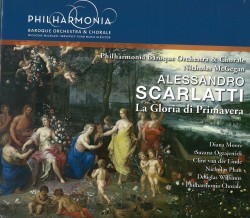 Alessandro Scarlatti – La Gloria di Primavera
Alessandro Scarlatti – La Gloria di Primavera

